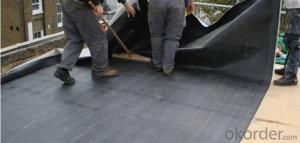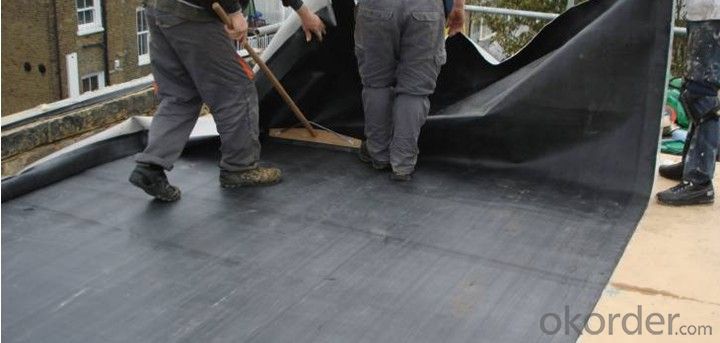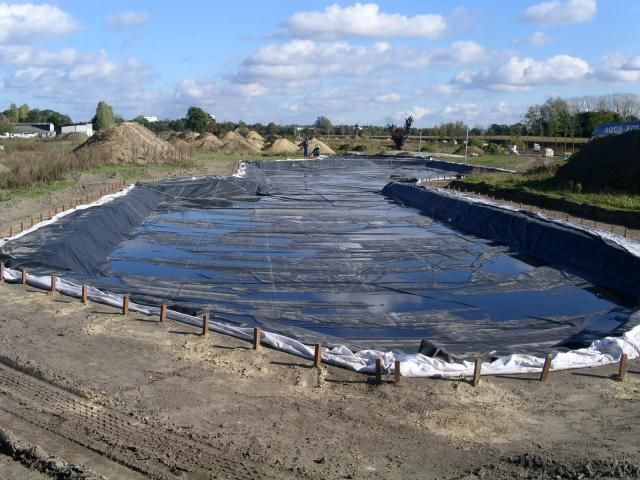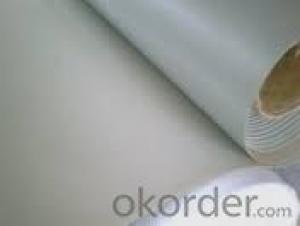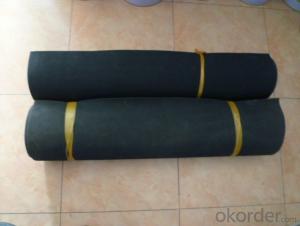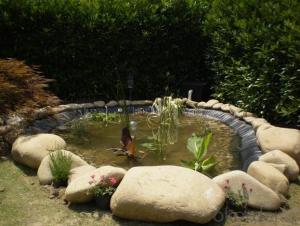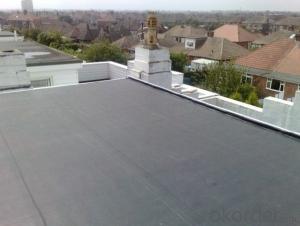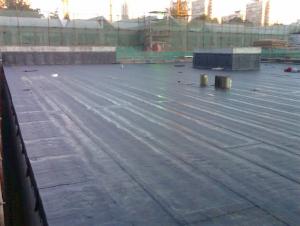EPDM Coiled Rubber Waterproof Membrane for Tall Building
- Loading Port:
- Shanghai
- Payment Terms:
- TT OR LC
- Min Order Qty:
- 50000 m²
- Supply Capability:
- 5000000 m²/month
OKorder Service Pledge
OKorder Financial Service
You Might Also Like
EPDM Coiled Rubber Waterproof Membrane for Tall Building
Description Of EPDM Coiled Rubber Waterproof Membrane for Tall Building:
•EPDM waterproof sheet has excellent anti-ozone-aging performance, able to resist ultraviolet light and corrosion of many chemical corrosive materials in the atmosphere
•It has high tensile strength, high ductility and strong retractility, it has excellent crack resistance, able to effect waterproof function even with tiny vibration of buildings.
• Excellent resistance to ozone, oxidation and sunlight.
• Resistance to chemicals; resistant to most inorganic products.
Main Features of EPDM Coiled Rubber Waterproof Membrane for Tall Building:
A.Polyester based SBS Modified Bitumen Waterproofing Membrane
a. Strong impermeability
b. High tensile strength, elongation, ability to adapt the grassroots shrinkage deformation and cracking
c. Puncture-resistant, broken resistant, tear-resistant
d. The corrosion resistance, resistance to mildew, weathering good
e. Construction convenient, hot-melt can be operated Four Seasons Construction, reliable joints
Specifications of EPDM Coiled Rubber Waterproof Membrane for Tall Building:
| Material | EPDM Rubber |
| Size | 1.2m (width)*20m (length) or customized, weldable type 2.05m or 4m width |
| Thick | 1.2mm, 1.5mm, 2.0mm |
| Type | Vulcanized & Weldable |
| Pattern | Non-reinforced (homogeneous) |
| Certificate | ISO9001/14001 |
Applications of EPDM Coiled Rubber Waterproof Membrane for Tall Building:
1. The substratum should be smooth, dry, clean, which can not have loosing and peeling phenomena.
2. Before application, clean up the basic level and eradicate the impurities.
3. Spread out the membrane on the substratum to loose sheet's stress. Use adhesive-glue to paint the substratum and the surface of membrane. When the adhesive is not sticky to hands, pave and press smoothly.
4. When pave the second volume of membrane, extrude 100mm of the edge of overlap of the first roll and do not paint with the adhesive. Pave the membrane on the substratum according to step so as to finish the whole pavement. When paving, do not tighten the waterproof membrane violently.
5. After that, use the special solvent to scrub the overlap joint. When it becomes fully dry , use the sheet glue to paint the both sides of the joint. Paint it again when it gets completely dry. Till the adhesive is not sticky to hands, press it smoothly and solidly.
6. Pay attention to fire prevention during application. Basement construction site shall be equipped with ventilation facilities
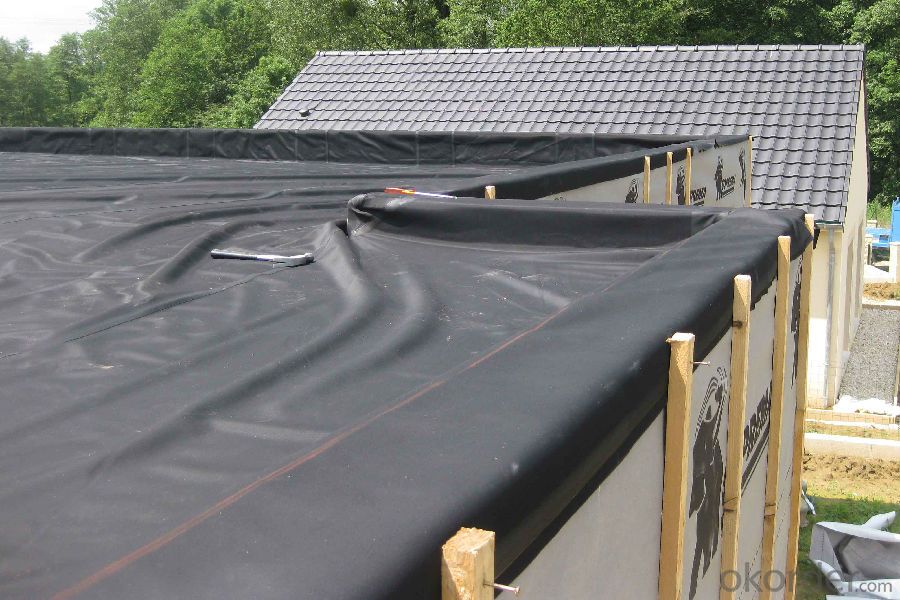


IMages of EPDM Coiled Rubber Waterproof Membrane for Tall Building:
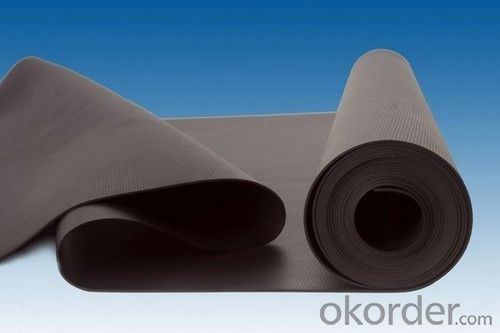



FAQ of EPDM Coiled Rubber Waterproof Membrane for Tall Building:
1. What are we supplying?
We are specialized in producing Colorful Asphalt Roof Shingle, SBS/APP modified bitumen waterproof membrane, Self adhesive bitumen waterproof membrane, PVC waterproofing membrane, EPDM rubber roofing membrane, Single Component Polyurethane Waterproof Coating, and Spray Polyurea Waterproof Coating
.
2. How Many years experience do we have?
We have been exported to more than 20 countries in the past 15 years.
3. How long do we usually reply your request?
We always reply our customer within 24 hours.
- Q: What are the common mistakes to avoid when installing a waterproofing membrane?
- To ensure the effectiveness and longevity of a waterproofing membrane, it is crucial to steer clear of certain common mistakes. These mistakes can include: 1. Insufficient surface preparation: One of the most prevalent errors is neglecting to adequately prepare the surface before membrane installation. This may involve not thoroughly cleaning the surface, leaving cracks or holes unfilled, or failing to remove loose debris. Inadequate surface preparation can compromise the membrane's adhesion and result in leaks. 2. Improper selection of membrane: Selecting the wrong type of waterproofing membrane can prove to be a costly blunder. Different membranes are designed for specific applications and environmental conditions. It is essential to choose a membrane that is suitable for the specific project requirements in order to ensure its effectiveness and durability. 3. Insufficient membrane overlap: Properly overlapping the membrane is crucial in creating a continuous barrier against water infiltration. Insufficient overlap can result in water seepage and jeopardize the integrity of the waterproofing system. It is important to adhere to the manufacturer's instructions regarding the recommended overlap width and ensure proper adhesion between the overlapped sections. 4. Incorrect membrane installation: Improper installation techniques can also lead to issues with the waterproofing membrane. This can include uneven application of the membrane or using incorrect installation tools. It is imperative to adhere to the manufacturer's guidelines and recommendations for installation to guarantee a proper and effective waterproofing system. 5. Neglecting proper drainage: Adequate drainage should always accompany waterproofing membranes. Failure to install proper drainage can lead to water pooling on the surface, which can cause membrane degradation and potential leaks. It is important to consider the slope and design of the drainage system to ensure efficient water removal. 6. Lack of regular inspection and maintenance: Once the waterproofing membrane is installed, regular inspections and maintenance are essential. Neglecting these can result in unnoticed issues such as damage or deterioration, which can compromise the waterproofing system. Regular inspections and timely repairs or maintenance can help extend the life of the membrane and prevent costly repairs in the future. By avoiding these common mistakes during the installation process and ensuring proper maintenance, you can enhance the effectiveness and longevity of your waterproofing membrane, providing reliable protection against water infiltration.
- Q: Can a waterproofing membrane be used for elevator shafts and stairwells?
- Yes, a waterproofing membrane can be used for elevator shafts and stairwells. Elevator shafts and stairwells are areas that are prone to moisture and water infiltration, especially in below-grade or high-moisture environments. Waterproofing membranes are designed to provide a barrier against water penetration and protect the structure from potential damage caused by moisture. When applied correctly, a waterproofing membrane can effectively prevent water from seeping into elevator shafts and stairwells, keeping them dry and free from water-related issues such as mold growth, deterioration of materials, and structural damage. These membranes are typically made from durable materials such as modified bitumen, PVC, or rubberized asphalt, which offer excellent waterproofing properties. It is important to choose a waterproofing membrane that is specifically designed for below-grade or high-moisture applications. These membranes should have high resistance to hydrostatic pressure, be capable of bridging cracks, and have long-term durability to withstand the constant exposure to moisture. Additionally, the installation of a waterproofing membrane in elevator shafts and stairwells should be done by trained professionals who have experience in waterproofing systems. This will ensure that the membrane is installed correctly, providing an effective barrier against water infiltration. In summary, a waterproofing membrane is a suitable solution for elevator shafts and stairwells as it can effectively prevent water penetration and protect the structure from moisture-related issues.
- Q: Can a waterproofing membrane be used on concrete block surfaces?
- Concrete block surfaces can indeed benefit from the application of a waterproofing membrane. These membranes are specifically designed to act as a shield against moisture and water infiltration, which makes them a popular choice for safeguarding concrete block surfaces against water-related harm and leaks. To achieve this, the membranes are either applied as a liquid or in sheet form, bonding to the surface of the concrete blocks and forming a protective layer that prevents water from seeping through. By reducing the risks of water damage, mold growth, and deterioration, the lifespan of the concrete blocks can be extended with the help of this waterproofing membrane. It is crucial to select a membrane that is specifically tailored for concrete block surfaces, and to follow the manufacturer's instructions carefully during installation to ensure optimal results.
- Q: Can a waterproofing membrane be used in steam rooms?
- Indeed, the utilization of a waterproofing membrane within steam rooms is possible. This specialized membrane is crafted to obstruct water infiltration and is commonly employed in areas where moisture is prevalent, such as bathrooms, showers, and steam rooms. The primary function of this membrane is to create a barrier that hinders water vapor from penetrating the underlying structure and inducing harm. In the case of steam rooms, where elevated levels of humidity and moisture are abundant, the implementation of a waterproofing membrane is imperative in safeguarding the walls, floors, and other surfaces from water damage and the growth of mold. It is of utmost importance to select a waterproofing membrane that is explicitly designed for environments with high moisture content, such as steam rooms, in order to ensure sufficient protection and durability. Furthermore, for the membrane to effectively fulfill its purpose within a steam room setting, proper installation and adherence to the guidelines provided by the manufacturer are essential.
- Q: Can a waterproofing membrane be applied to tiled surfaces?
- Yes, a waterproofing membrane can be applied to tiled surfaces. The membrane is typically installed underneath the tiles to provide an additional layer of protection against water damage.
- Q: Can a waterproofing membrane be used for theme parks or amusement centers?
- Yes, a waterproofing membrane can be used for theme parks or amusement centers. These types of facilities often have water features, pools, or water rides that require effective waterproofing to prevent leaks or water damage. Waterproofing membranes provide a reliable and durable solution to keep these areas watertight, ensuring the safety and longevity of the park or center.
- Q: Can a waterproofing membrane be used for a basement floor slab?
- Yes, a waterproofing membrane can be used for a basement floor slab. A waterproofing membrane is designed to prevent water and moisture from seeping into the surface it is applied to. This makes it an ideal solution for protecting basement floor slabs from potential water damage. By installing a waterproofing membrane on the basement floor slab, you can create a barrier that effectively prevents water penetration, reducing the risk of water damage, mold growth, and structural issues. Additionally, a waterproofing membrane can also serve as a vapor barrier, preventing moisture from rising up through the slab and causing issues such as dampness or high humidity levels in the basement. Overall, using a waterproofing membrane for a basement floor slab is a smart choice to ensure the long-term durability and protection of the basement.
- Q: Can a waterproofing membrane be used on stucco surfaces?
- Yes, a waterproofing membrane can be used on stucco surfaces. Stucco is a porous material that can absorb water, so applying a waterproofing membrane can help prevent water infiltration and damage. The waterproofing membrane acts as a barrier, preventing water from seeping through the stucco and into the underlying structure. It also helps to protect the stucco from moisture-related issues such as cracking, mold, and mildew. It is important to choose a waterproofing membrane that is specifically designed for stucco surfaces and to follow the manufacturer's instructions for proper application. Additionally, regular inspections and maintenance of the waterproofing membrane are recommended to ensure its effectiveness and longevity.
- Q: Can a waterproofing membrane be used on plastic block surfaces?
- Yes, a waterproofing membrane can be used on plastic block surfaces. These membranes are designed to provide a protective barrier against moisture, preventing water from seeping through the surface. Plastic blocks, like any other surface, can be susceptible to water damage if not properly protected. Applying a waterproofing membrane can help seal and protect the plastic blocks, preventing water penetration and potential damage. It is important to choose a waterproofing membrane that is compatible with plastic materials and follow the manufacturer's instructions for application to ensure the best results.
- Q: Can a waterproofing membrane be used for a sports facility?
- Indeed, a sports facility can benefit from the utilization of a waterproofing membrane. Its purpose lies in safeguarding structures against water harm by establishing a barrier that effectively obstructs water infiltration. Within a sports facility, where water-related activities like swimming pools, showers, or even outdoor sports fields may occur, a waterproofing membrane presents itself as a valuable solution to maintain a dry environment and shield the structure from water-induced damage. Furthermore, employing a waterproofing membrane can also secure the foundation of the sports facility against water penetration, which, if left unattended, may result in structural complications over time. In summary, the inclusion of a waterproofing membrane in a sports facility not only guarantees its endurance and resilience but also furnishes athletes and visitors with a secure and dry atmosphere.
Send your message to us
EPDM Coiled Rubber Waterproof Membrane for Tall Building
- Loading Port:
- Shanghai
- Payment Terms:
- TT OR LC
- Min Order Qty:
- 50000 m²
- Supply Capability:
- 5000000 m²/month
OKorder Service Pledge
OKorder Financial Service
Similar products
Hot products
Hot Searches
Related keywords
